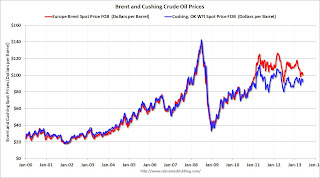by Calculated Risk on 6/29/2013 05:54:00 PM
Saturday, June 29, 2013
Oil: The Disappearing Brent / WTI Spread
The WSJ Real Time Economics has an article today on the declining spread between Brent crude oil and West Texas Intermediate (WTI). (note: this is something we discussed a few weeks ago).
From Ben Casselman at the WSJ: Number of the Week: U.S. Oil Boom Affecting Global Prices
The U.S. pumped 6.5 million barrels a day of oil last year, according to the Energy Information Administration, the most since the mid-1990s, and production has continued to surge; April’s figure of 7.4 million barrels per day marked the best month in more than two decades.But, until the gap disappears completely, we still need to use Brent crude prices to forecast U.S. gasoline prices.
...
The industry wasn’t expecting the huge surge in production from North Dakota, so companies didn’t have the pipelines in place to handle all the new oil. So rather than flow into the global market, much of the oil stayed in the middle of the U.S.
Now, however, the gap between WTI and Brent is starting to narrow, as a new report from the Energy Information Administration makes clear. The industry has expanded pipeline capacity and found other ways, such as rail cars, to get oil from the middle of the country to major demand centers on the coasts. Meanwhile, coastal refineries are shifting to use more domestic crudes, leading to lower demand for Brent. The result: The gap between the two prices has narrowed to under $10 per barrel.
 Click on graph for larger image.
Click on graph for larger image.Here is an update to the graph in the previous post that shows the divergence between Brent and Cushing starting in 2011.
Recently the spread has been closing. At one point Brent was selling for about 25% more than WTI (even though they are comparable quality). Now the difference is under 7% (and less than $7 per barrel).


